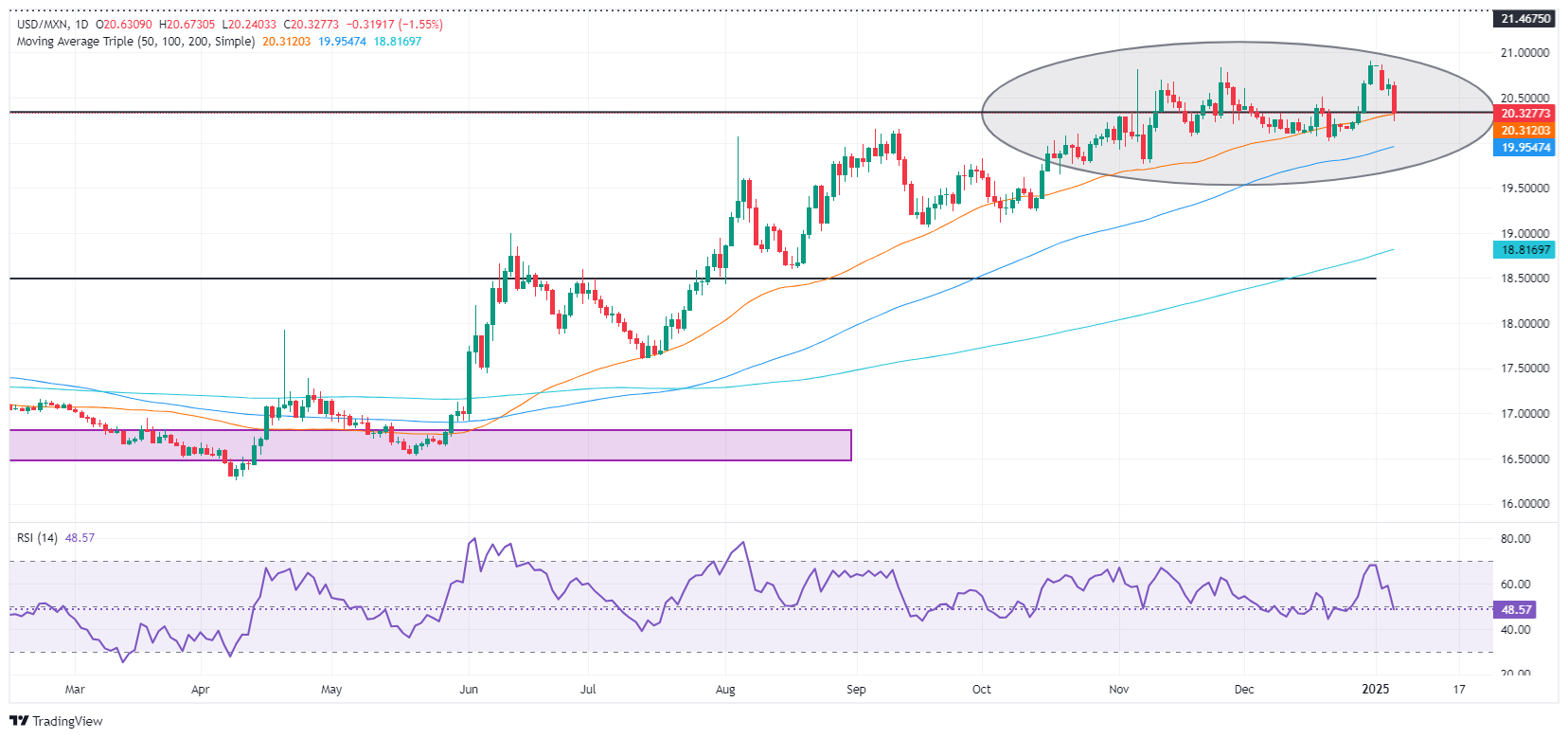Most recent article: Mexican Peso holds steady after strong US PMI, jobs data
- Mexican Peso appreciates, pushing USD/MXN down over 1.5% to 20.28 following tariff speculation in The Washington Post.
- US services sector decelerates in December, compounding investor caution amidst fluctuating equity markets.
- Falling Mexican consumer confidence adds to local economic concerns.
The Mexican Peso begins the week positively, appreciating against the US Dollar on Monday after The Washington Post reported that Trump aides are only considering tariffs on “certain sectors”, a less harsh policy than floated earlier. Nevertheless, US President-elect Trump said the story “incorrectly states that my tariff policy will be pared back.” Despite this, the USD/MXN tumbled over 1.50% to trade at 20.28 at the time of writing.
Market sentiment is upbeat, yet traders remain wary of Trump’s remarks on his social network. US equities wavered after The Washington Post article, yet they are still holding their gains following Trump’s latest remarks.
Recent data revealed that US business activity in the services segment decelerated in December, based on data from S&P Global. Additionally, Factory Orders in November shrank after strong figures in October.
Meanwhile, Federal Reserve Governor Lisa Cook revealed that the US central bank could adopt a cautious approach with additional interest rate cuts, given a solid economy and inflation that is stickier than expected.
Across the south of the border, the Instituto Nacional de Estadistica Geografia e Informatica (INEGI) announced that Mexican consumers turned pessimistic near the end of 2024 as Consumer Confidence fell for the second straight month in December.
Daily digest market movers: Mexican Peso boosted by weak US Dollar
- The US Dollar Index (DXY) is falling to a five-day low of 107.75, a headwind for the USD/MXN exotic pair.
- The DXY weakness was spurred by The Washington Post's article about Trump’s tariff plans.
- US S&P Global Services PMI in December slowed from 58.5 to 56.8, exceeding estimates of 56.1.
- US Factory Orders in November dropped by 0.4% MoM from October’s upwardly-revised figures of 0.5%. Economists expected a contraction of -0.3%.
- Mexico’s Consumer Confidence in December was 47.1, down from 47.6 in the previous month, according to the national statistics agency on Monday.
- S&P Global revealed that the US Services PMI dipped to 56.8 from 58.5, higher than forecasts of 56.1.
USD/MXN technical outlook: Mexican Peso strengthens, testing key level ahead 20.00
The USD/MXN is falling sharply, testing the 50-day Simple Moving Average (SMA) at 20.26. The Relative Strength Index (RSI) turned bearish, opening the door for further Mexican Peso strength. If sellers push prices below the latter, they could challenge the 20.00 figure. On further weakness, the pair could drop to the 100-day SMA at 19.89, followed by the 19.50 figure.
On the other hand, if buyers stepped in and lifted the USD/MXN above 20.50, the next key resistance would be the year-to-date (YTD) high of 20.90 before testing 21.00. A breach of the latter will expose the March 8, 2022 peak of 21.46.
Mexican Peso FAQs
The Mexican Peso (MXN) is the most traded currency among its Latin American peers. Its value is broadly determined by the performance of the Mexican economy, the country’s central bank’s policy, the amount of foreign investment in the country and even the levels of remittances sent by Mexicans who live abroad, particularly in the United States. Geopolitical trends can also move MXN: for example, the process of nearshoring – or the decision by some firms to relocate manufacturing capacity and supply chains closer to their home countries – is also seen as a catalyst for the Mexican currency as the country is considered a key manufacturing hub in the American continent. Another catalyst for MXN is Oil prices as Mexico is a key exporter of the commodity.
The main objective of Mexico’s central bank, also known as Banxico, is to maintain inflation at low and stable levels (at or close to its target of 3%, the midpoint in a tolerance band of between 2% and 4%). To this end, the bank sets an appropriate level of interest rates. When inflation is too high, Banxico will attempt to tame it by raising interest rates, making it more expensive for households and businesses to borrow money, thus cooling demand and the overall economy. Higher interest rates are generally positive for the Mexican Peso (MXN) as they lead to higher yields, making the country a more attractive place for investors. On the contrary, lower interest rates tend to weaken MXN.
Macroeconomic data releases are key to assess the state of the economy and can have an impact on the Mexican Peso (MXN) valuation. A strong Mexican economy, based on high economic growth, low unemployment and high confidence is good for MXN. Not only does it attract more foreign investment but it may encourage the Bank of Mexico (Banxico) to increase interest rates, particularly if this strength comes together with elevated inflation. However, if economic data is weak, MXN is likely to depreciate.
As an emerging-market currency, the Mexican Peso (MXN) tends to strive during risk-on periods, or when investors perceive that broader market risks are low and thus are eager to engage with investments that carry a higher risk. Conversely, MXN tends to weaken at times of market turbulence or economic uncertainty as investors tend to sell higher-risk assets and flee to the more-stable safe havens.
Information on these pages contains forward-looking statements that involve risks and uncertainties. Markets and instruments profiled on this page are for informational purposes only and should not in any way come across as a recommendation to buy or sell in these assets. You should do your own thorough research before making any investment decisions. FXStreet does not in any way guarantee that this information is free from mistakes, errors, or material misstatements. It also does not guarantee that this information is of a timely nature. Investing in Open Markets involves a great deal of risk, including the loss of all or a portion of your investment, as well as emotional distress. All risks, losses and costs associated with investing, including total loss of principal, are your responsibility. The views and opinions expressed in this article are those of the authors and do not necessarily reflect the official policy or position of FXStreet nor its advertisers. The author will not be held responsible for information that is found at the end of links posted on this page.
If not otherwise explicitly mentioned in the body of the article, at the time of writing, the author has no position in any stock mentioned in this article and no business relationship with any company mentioned. The author has not received compensation for writing this article, other than from FXStreet.
FXStreet and the author do not provide personalized recommendations. The author makes no representations as to the accuracy, completeness, or suitability of this information. FXStreet and the author will not be liable for any errors, omissions or any losses, injuries or damages arising from this information and its display or use. Errors and omissions excepted.
The author and FXStreet are not registered investment advisors and nothing in this article is intended to be investment advice.
Recommended content
Editors’ Picks

EUR/USD off highs, back to the 1.1050 area ahead of Fed Minutes
EUR/USD keeps its bullish stance well in place, adding to Tuesday's uptick and retesting the vicinity of the 1.1100 neighbourhood on the back of the intense sell-off in the Greenback, all amid steady concerns over the impact of the China-US trade war.

GBP/USD eases to daily lows near 1.2750, USD picks up pace
The recovery attempt in the US Dollar is now prompting GBP/USD to give away part of the earlier advance past 1.2800 the figure and recedes to the mid-1.2700s in a context still widely favourable to the risk complex.

Gold climbs further, retargets $3,100
Gold preserves its bullish momentum and approaches the $3,100 level per troy ounce on Wednesday, underpinned by the steady safe-haven demand in response to trade tensions between the US and China.

Fed Minutes to offer clues on rate cut outlook amid tariff uncertainty
The eagerly awaited minutes from the US Fed’s March 18-19 monetary policy meeting are set for release on Wednesday at 18:00 GMT. During the gathering, policymakers agreed to keep the Fed Funds Target Range (FFTR) unchanged at 4.25%-4.50%.

Tariff rollercoaster continues as China slapped with 104% levies
The reaction in currencies has not been as predictable. The clear winners so far remain the safe-haven Japanese yen and Swiss franc, no surprises there, while the euro has also emerged as a quasi-safe-haven given its high liquid status.

The Best brokers to trade EUR/USD
SPONSORED Discover the top brokers for trading EUR/USD in 2025. Our list features brokers with competitive spreads, fast execution, and powerful platforms. Whether you're a beginner or an expert, find the right partner to navigate the dynamic Forex market.




